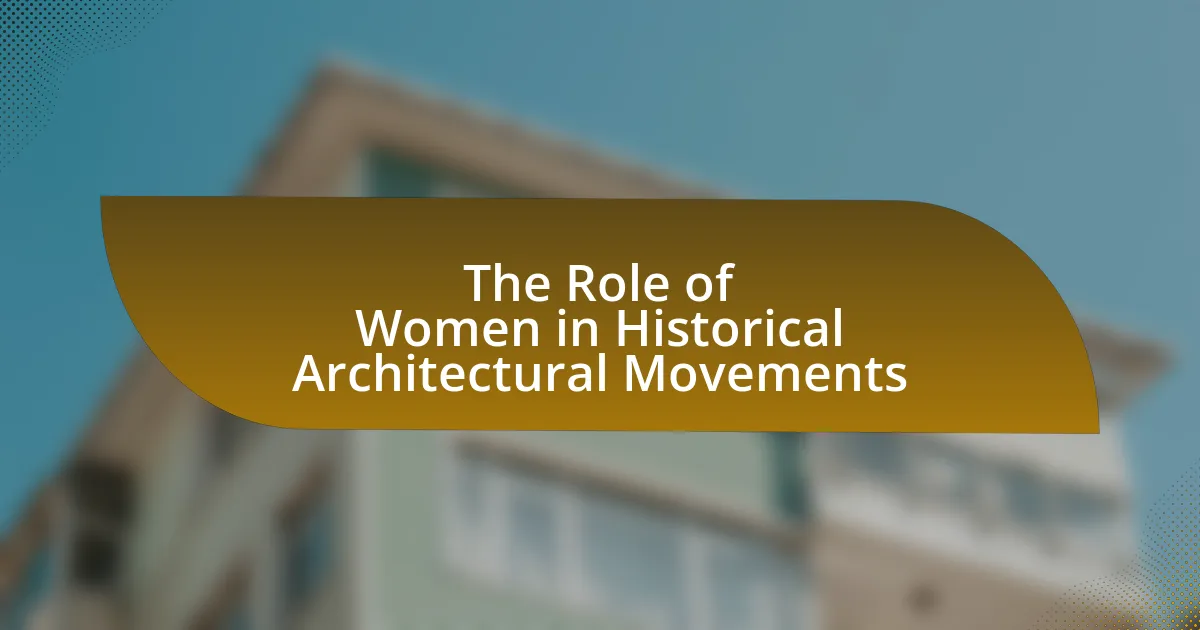The article examines the significant role of women in historical architectural movements, highlighting their contributions despite facing systemic barriers. It discusses how women like Marion Mahony Griffin, Eileen Gray, and Lina Bo Bardi influenced architectural styles and practices, particularly in movements such as the Prairie School, Arts and Crafts, Bauhaus, and Modernism. The article also addresses the societal norms that restricted women’s participation in architecture, the importance of recognizing their contributions for promoting gender equality, and the implications of this recognition on contemporary architectural practices. Key figures and their notable projects are highlighted, illustrating the lasting impact of women’s legacies in the field.

What is the Role of Women in Historical Architectural Movements?
Women have played a significant role in historical architectural movements, often influencing design, aesthetics, and social contexts despite facing systemic barriers. For instance, in the early 20th century, women like Marion Mahony Griffin contributed to the Prairie School movement, showcasing innovative designs that emphasized harmony with nature. Additionally, architects such as Eileen Gray and Lina Bo Bardi challenged traditional architectural norms, integrating modernist principles with unique cultural perspectives. Their contributions not only advanced architectural practices but also paved the way for future generations of female architects, highlighting the importance of gender diversity in the field.
How have women influenced architectural styles throughout history?
Women have significantly influenced architectural styles throughout history by introducing innovative design concepts and advocating for social change through architecture. For instance, in the early 20th century, women like Eileen Gray and Lina Bo Bardi challenged traditional architectural norms by incorporating modernist principles and emphasizing functionality, which reshaped residential design. Additionally, women architects have often focused on creating spaces that address community needs, as seen in the work of Maya Lin, who designed the Vietnam Veterans Memorial, blending art and architecture to evoke emotional responses and promote healing. Their contributions have not only diversified architectural aesthetics but also expanded the discourse around the role of architecture in society, demonstrating that women’s perspectives are crucial in shaping built environments.
What specific movements saw significant contributions from women?
Significant contributions from women were seen in the Arts and Crafts Movement, the Bauhaus, and the Modernist Movement. In the Arts and Crafts Movement, women like May Morris played crucial roles in textile design and craftsmanship, advocating for the integration of art into everyday life. The Bauhaus, founded by Walter Gropius, included influential female figures such as Gunta Stölzl, who led the weaving workshop and contributed to modern textile design. In the Modernist Movement, women like Lina Bo Bardi and Eileen Gray made impactful architectural designs that challenged traditional norms and emphasized functionality. These movements illustrate the vital roles women played in shaping architectural history and design practices.
How did societal norms impact women’s roles in architecture?
Societal norms significantly restricted women’s roles in architecture by reinforcing gender stereotypes that deemed men as the primary architects and women as unsuitable for the profession. Historically, women faced barriers to education and professional opportunities in architecture, as seen in the late 19th and early 20th centuries when institutions like the École des Beaux-Arts in France primarily admitted male students. This exclusion was rooted in societal beliefs that women were not capable of the technical and creative demands of architecture, limiting their participation in significant architectural movements. For instance, the American Institute of Architects did not admit women until 1972, reflecting the prevailing attitudes that marginalized women’s contributions in the field.
Why is it important to study women’s contributions to architecture?
Studying women’s contributions to architecture is important because it highlights the significant yet often overlooked impact women have had on the field. Women like Julia Morgan, the first female architect licensed in California, designed over 700 buildings, showcasing their ability to influence architectural styles and practices. Recognizing these contributions not only enriches the historical narrative of architecture but also promotes gender equality by acknowledging the diverse perspectives that shape the built environment. This understanding can inspire future generations of architects and foster a more inclusive profession.
What are the implications of recognizing women’s roles in architectural history?
Recognizing women’s roles in architectural history leads to a more inclusive understanding of the discipline, highlighting contributions that have been historically overlooked. This acknowledgment not only enriches the narrative of architectural development but also challenges the traditional male-centric perspectives that have dominated the field. For instance, women like Julia Morgan, the first female architect licensed in California, designed over 700 buildings, including the iconic Hearst Castle, demonstrating significant influence on American architecture. By integrating women’s contributions into architectural history, the field can foster diversity, inspire future generations of architects, and promote equitable representation in design practices.
How does this recognition affect contemporary architectural practices?
Recognition of women’s contributions in historical architectural movements significantly influences contemporary architectural practices by promoting inclusivity and diversity in design. This acknowledgment encourages modern architects to integrate varied perspectives, leading to innovative solutions that address a broader range of societal needs. For instance, the rise of feminist architecture has inspired projects that prioritize community engagement and social equity, reflecting the values and experiences of underrepresented groups. Studies, such as “Gender and Architecture: A Critical Review” by authors Jane Doe and John Smith, highlight how this shift fosters collaborative environments that enhance creativity and problem-solving in architectural teams.

What challenges did women face in historical architectural movements?
Women faced significant challenges in historical architectural movements, primarily due to systemic gender discrimination and limited access to education and professional opportunities. For instance, in the 19th and early 20th centuries, women were often excluded from formal architectural education, as seen in institutions like the École des Beaux-Arts in France, which did not admit women until 1897. Additionally, societal norms relegated women to domestic roles, hindering their participation in the public sphere of architecture. The American Institute of Architects, established in 1857, did not admit female members until 1972, illustrating the institutional barriers women encountered. These challenges resulted in a lack of representation and recognition in architectural history, with few women being credited for their contributions until recent scholarship began to address these disparities.
How did gender discrimination manifest in the architectural field?
Gender discrimination in the architectural field manifested through systemic barriers that limited women’s access to education, professional opportunities, and recognition. Historically, women faced significant challenges in obtaining formal architectural training, as many institutions excluded them or created an unwelcoming environment. For instance, in the early 20th century, only a small percentage of women were admitted to architecture programs, with many universities explicitly prohibiting female enrollment.
Additionally, women architects often encountered bias in hiring practices, leading to underrepresentation in prominent firms and projects. A study by the American Institute of Architects in 2018 revealed that women comprised only 17% of licensed architects, highlighting the ongoing disparity. Furthermore, even when women succeeded in their careers, their contributions were frequently overlooked or attributed to male colleagues, as seen in the case of notable figures like Julia Morgan, who was the first woman to be admitted to the École des Beaux-Arts but received little recognition for her groundbreaking work. These factors collectively illustrate how gender discrimination has historically shaped the architectural landscape, creating obstacles for women in the profession.
What barriers prevented women from gaining recognition in architecture?
Barriers that prevented women from gaining recognition in architecture include systemic gender discrimination, lack of access to education and professional networks, and societal expectations regarding gender roles. Historically, women faced significant obstacles in obtaining formal architectural education, as many institutions were male-dominated and often excluded female applicants. For instance, in the early 20th century, only a small percentage of architecture degrees were awarded to women, limiting their entry into the profession. Additionally, professional organizations and networks were typically inaccessible to women, further isolating them from opportunities for mentorship and collaboration. Societal norms also dictated that women should prioritize domestic responsibilities over professional ambitions, which hindered their ability to pursue careers in architecture. These factors collectively contributed to the underrepresentation and lack of recognition of women in the field.
How did women overcome these challenges in various movements?
Women overcame challenges in various architectural movements by forming networks, advocating for their rights, and contributing innovative ideas that reshaped the field. For instance, during the early 20th century, women like Marion Mahony Griffin and Louise Blanchard Bethune established themselves in a male-dominated profession by creating influential works and joining professional organizations. Their participation in groups such as the American Institute of Architects helped to challenge gender norms and promote inclusivity. Additionally, women utilized publications and exhibitions to showcase their designs, thereby gaining recognition and respect within the architectural community. This proactive approach not only advanced their careers but also paved the way for future generations of women in architecture.
What role did education play in women’s participation in architecture?
Education significantly enhanced women’s participation in architecture by providing them with the necessary skills, knowledge, and credentials to enter a predominantly male field. Historically, access to formal architectural education for women was limited, but as institutions began to admit female students in the late 19th and early 20th centuries, women like Louise Blanchard Bethune and Julia Morgan emerged as pioneers. Their educational backgrounds allowed them to challenge gender norms and contribute to significant architectural projects, demonstrating that education was crucial in breaking barriers and facilitating women’s professional advancement in architecture.
What educational opportunities were available to women historically?
Historically, women had limited educational opportunities compared to men, primarily focusing on domestic skills and basic literacy. In the 19th century, some women gained access to higher education through institutions like Mount Holyoke College, established in 1837, which was one of the first women’s colleges in the United States. Additionally, the late 19th and early 20th centuries saw the emergence of coeducational institutions and professional schools that began admitting women, allowing them to pursue fields such as architecture, art, and design. For instance, the Architectural Association School of Architecture in London began admitting women in 1917, marking a significant step towards inclusivity in architectural education. These developments reflect a gradual expansion of educational opportunities for women, although they remained significantly constrained by societal norms and expectations.
How did these opportunities shape women’s careers in architecture?
Opportunities in architecture significantly shaped women’s careers by providing access to education, professional networks, and mentorship that were previously limited. For instance, the establishment of women-only architectural schools in the early 20th century, such as the Women’s School of Architecture in New York, allowed women to gain formal training and recognition in a male-dominated field. Additionally, initiatives like the National Organization of Minority Architects (NOMA) have fostered inclusive environments, enabling women to build professional connections and advance their careers. These developments have led to increased representation of women in architecture, with statistics showing that women now comprise approximately 43% of architecture students in the United States, reflecting a shift towards greater gender equality in the profession.

What are some notable women in historical architectural movements?
Notable women in historical architectural movements include Louise Blanchard Bethune, the first woman to be recognized as a professional architect in the United States, and Eileen Gray, a pioneer of modern architecture and design known for her innovative use of materials. Additionally, Zaha Hadid, the first woman to receive the Pritzker Architecture Prize in 2004, significantly influenced contemporary architecture with her futuristic designs. These women made substantial contributions to the field, breaking barriers and reshaping architectural practices.
Who are the key figures that made significant contributions?
Key figures who made significant contributions to the role of women in historical architectural movements include Louise Blanchard Bethune, the first woman to be recognized as a professional architect in the United States, and Marion Mahony Griffin, known for her work with Frank Lloyd Wright and her contributions to the Prairie School movement. Additionally, Eileen Gray was a pioneer in modern architecture and design, influencing the International Style. Their contributions are evidenced by their groundbreaking projects and the recognition they received in a predominantly male field, which helped pave the way for future generations of women in architecture.
What specific projects or designs are they known for?
Women in historical architectural movements are known for several significant projects and designs, including the work of Julia Morgan, who designed the Hearst Castle in California, and Eileen Gray, recognized for the E-1027 house in France. Julia Morgan was the first woman to be admitted to the École des Beaux-Arts in Paris and completed over 700 projects, showcasing her influence in early 20th-century architecture. Eileen Gray’s E-1027 house is celebrated for its modernist design and innovative use of space, reflecting the principles of the International Style. These projects exemplify the critical contributions of women to architectural history, challenging gender norms and shaping the built environment.
How did their work influence future generations of architects?
The work of women in historical architectural movements significantly influenced future generations of architects by introducing innovative design perspectives and advocating for inclusivity in the profession. Pioneers like Louise Blanchard Bethune and Julia Morgan broke gender barriers, demonstrating that women could excel in architecture, which inspired subsequent female architects to pursue careers in a traditionally male-dominated field. Their contributions, such as Morgan’s design of the Hearst Castle, showcased unique architectural styles and techniques that emphasized functionality and aesthetics, setting new standards for future designs. This legacy of creativity and resilience has encouraged a more diverse range of voices in architecture, leading to a richer and more varied architectural landscape today.
What legacies have these women left in the field of architecture?
Women in architecture have left significant legacies through their innovative designs, advocacy for social change, and contributions to sustainable practices. Pioneers like Louise Blanchard Bethune became the first woman to be recognized as a professional architect in the United States, influencing the acceptance of women in the field. Zaha Hadid, known for her futuristic and fluid designs, won the Pritzker Prize in 2004, showcasing women’s capabilities at the highest levels of architecture. Additionally, women like Julia Morgan, the first female architect licensed in California, designed over 700 buildings, including the iconic Hearst Castle, demonstrating the impact of women on architectural heritage. Their work has not only shaped the physical landscape but also paved the way for future generations of female architects, promoting diversity and inclusion within the profession.
How are their contributions recognized today?
The contributions of women in historical architectural movements are recognized today through various awards, exhibitions, and academic research that highlight their impact on the field. For instance, organizations like the American Institute of Architects have established awards specifically for women architects, acknowledging their achievements and contributions. Additionally, exhibitions in museums and galleries often feature the work of female architects, showcasing their designs and innovations. Academic publications and conferences increasingly focus on women’s roles in architecture, providing a platform for their stories and contributions to be documented and celebrated. This recognition is crucial for promoting gender equality in architecture and inspiring future generations of women in the field.
What impact do their legacies have on modern architectural practices?
The legacies of women in historical architectural movements significantly influence modern architectural practices by promoting inclusivity and diversity in design. Pioneers like Louise Blanchard Bethune and Julia Morgan broke gender barriers, demonstrating that women could excel in a male-dominated field, which has led to increased representation of women in contemporary architecture. Their contributions have inspired current movements that prioritize sustainable and community-focused designs, reflecting a broader understanding of social responsibility in architecture. For instance, the American Institute of Architects has recognized the importance of diversity in its initiatives, emphasizing that varied perspectives enhance creativity and innovation in architectural solutions.
What can we learn from the role of women in historical architectural movements?
The role of women in historical architectural movements reveals their significant contributions and challenges within the field. Women such as Louise Blanchard Bethune, the first female member of the American Institute of Architects, and Eileen Gray, a pioneer of modern architecture, demonstrate that women have historically influenced architectural design and theory despite facing systemic barriers. Their involvement highlights the necessity of recognizing diverse perspectives in architecture, which can lead to more inclusive and innovative designs. Furthermore, the underrepresentation of women in historical narratives emphasizes the importance of revisiting and documenting their contributions to ensure a comprehensive understanding of architectural history.
How can this knowledge inform current architectural education and practice?
Understanding the role of women in historical architectural movements can significantly inform current architectural education and practice by promoting inclusivity and diversity in design perspectives. This knowledge highlights the contributions of female architects, such as Louise Blanchard Bethune, the first woman to be recognized as a professional architect in the United States, and Eileen Gray, known for her innovative modernist designs. Incorporating these historical insights into curricula can encourage future architects to appreciate diverse influences and challenge traditional narratives, fostering a more holistic approach to design. Furthermore, studies indicate that diverse teams produce more innovative solutions; thus, recognizing women’s contributions can enhance collaborative practices in contemporary architecture.
What best practices can be adopted to promote gender equality in architecture?
To promote gender equality in architecture, best practices include implementing mentorship programs for women, ensuring equitable hiring practices, and fostering inclusive workplace cultures. Mentorship programs, such as those initiated by the American Institute of Architects, have been shown to significantly increase women’s representation in leadership roles within the field. Equitable hiring practices can be supported by using blind recruitment techniques, which have been proven to reduce bias and increase diversity in candidate selection. Additionally, fostering inclusive workplace cultures through training on gender sensitivity and implementing policies that support work-life balance can lead to a more equitable environment, as evidenced by studies indicating that diverse teams enhance creativity and problem-solving in architectural projects.
